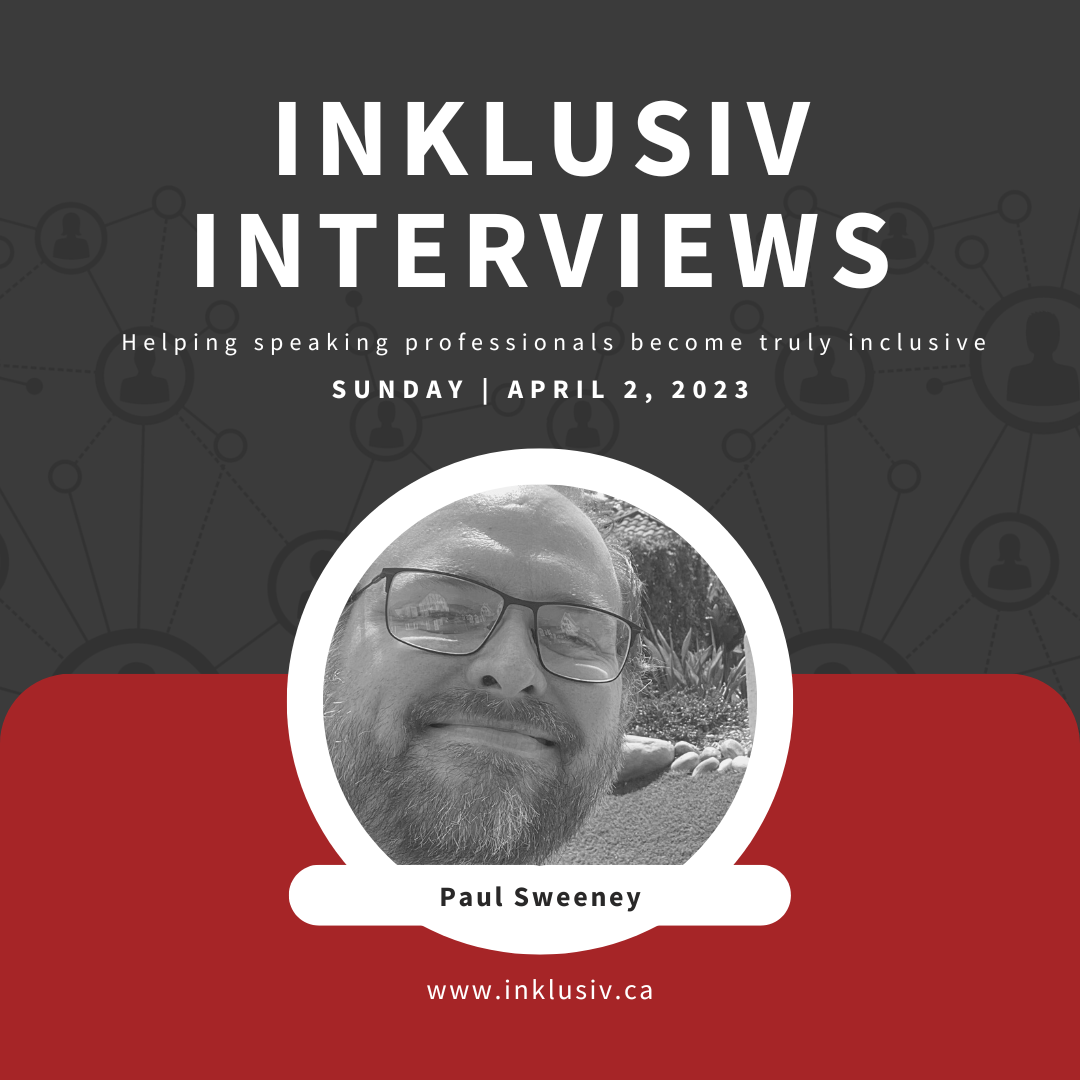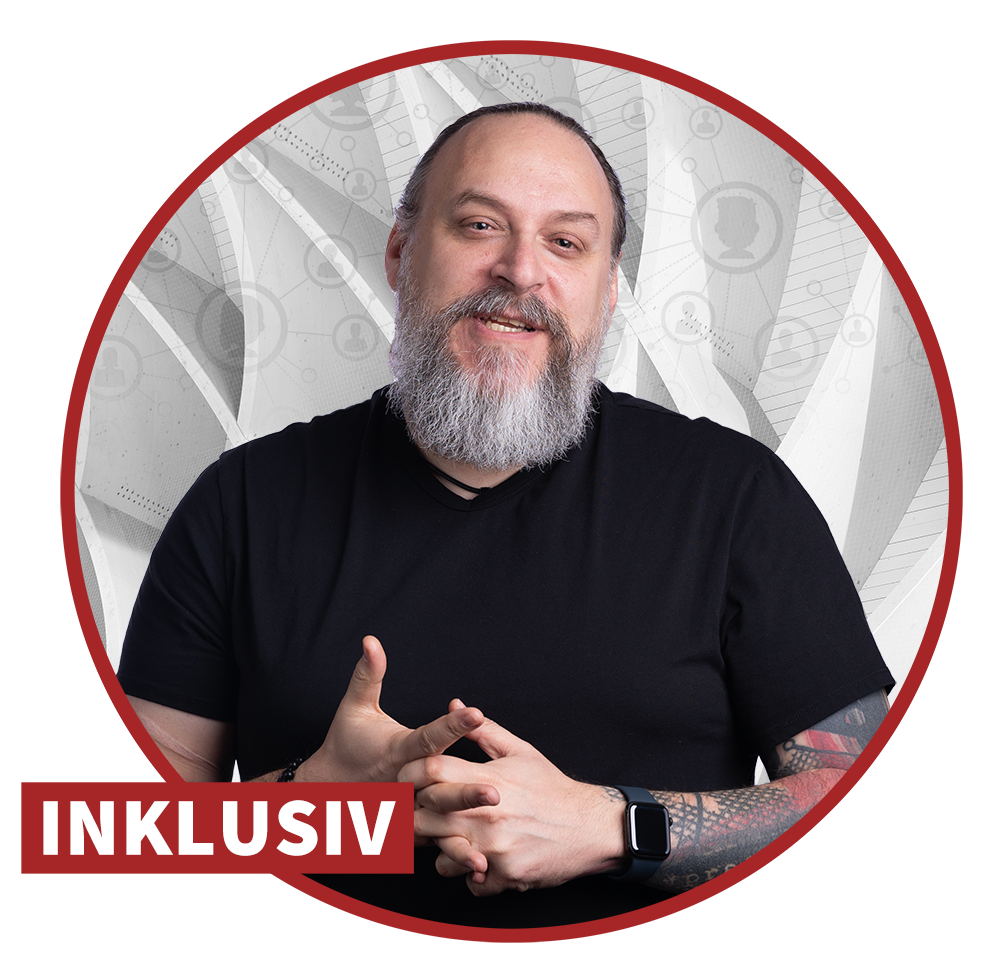Interview with Paul Sweeney Jr.

Every week, we meet with audience members with disabilities who are willing to come forward and share a little bit about their own personal journey and experiences, attending live, in-person, or virtual speaking or training events. Through their unique and generous perspectives, speakers, trainers, facilitators, and other communication professionals can hopefully learn about some of the things that they do well, but also (and maybe more importantly) about some of the things they could improve to provide an experience that is truly inclusive of everyone.
Meet Paul, an audience member who is deaf
So, without further ado, let’s dive right into this week’s interview with Paul Sweeney (he/him). Paul is deaf, and comes to us from Grover Beach, California.
Introductions
QUESTION 01 Can you tell us a bit about yourself, and how your disability might impact your experience, as someone who attends live in-person and virtual events?
I don’t speak or hear. My thought process is visual when it comes to language and communication. At some point, attending events with captions service would burn me out because I am reading/writing in English all day long with people who don’t communicate or know sign language. English is not my native language because I didn’t grow up hearing speakers in English, but I grew up communicating in sign language with my family and friends. I am more comfortable having sign language interpreters at events, because it is my native language.
Things that ruin the experience
QUESTION 02 Thinking back on some of your experiences attending in-person or virtual events, what are some of the worst things speakers, trainers, and other communication experts can do to ruin your experience as an attendee?
I remember attending Apple’s virtual event for their Worldwide Developers Conference. I thought my experience would be great there because it’s APPLE! The giant company that cares about accessibility. But, it was not what I thought it should be.
When they streamed live on their opening presentation, there were no ASL interpreters but then they posted the link to the ASL version of the event later on. Of course, captions are there but again, English isn’t my native language and I’m more comfortable with sign language.This experience got me and I wrote a blog post about it. You can read it at: blog.vphreak.net/with-my-eyes-at-wwdc21.
In short, Apple didn’t provide ASL interpreters for their sessions for the entire week. I was really disappointed and I made a valid argument that if I showed up at their in-person event, they would pair me with ASL interpreters all through the week.
Things that make a positive impact
QUESTION 03 Can you share some of the great things speakers, trainers, and other communication experts sometimes do that make a positive impact on your ability to fully enjoy your in-person or virtual event experiences?
One huge positive impact is when they actually make you feel included by acknowledging your communication accommodation. It can be something like building a relationship with ASL interpreters before the presentation. Once they have the connection with ASL interpreters, they can bring amazing presentations. When deaf attendees like me show up, we might be in the front row or hidden somewhere in the audience. But mostly, we are nearby because of access to the interpreters at the front.
ASL interpreters will always work with deaf attendees and find their comfortable zone such as where will the interpreter stands. Whenever deaf attendees see that ASL interpreters have a good communication relationship with the person speaking, it builds a bridge between two worlds – hearing and deaf.
Sharing a piece of advice
QUESTION 04 If you had one piece of advice to give speakers, trainers, and other communication experts, so their content became more inclusive of people who have disabilities, what would it be?
Always check in with ASL interpreters and build a relationship with them, because they will be your voice for deaf attendees, you would want to make sure your thoughts are passed across the bridge correctly and clearly. It will be super helpful to pass down your speaking notes to ASL interpreters, and go through them.
Most of the time, there are two interpreters there and they support each other with the translation. When you work with them, they might develop a signal where they want some clarification so they can translate your speaking into sign language correctly.
Be open to any questions being asked in the middle of the presentation. Also, share copies or links to your presentation slides. If you are going to use the presentation slides, it will be super helpful if you give a moment for deaf attendees to read them before or after speaking on a slide.
Wrapping up
QUESTION 05 Thank you for sharing some of your insights with us today. As we wrap up our conversation, is there anything that you’d like to add, such as another thought, another piece of advice, another perspective, etc.?
I also wrote another blog post on subtitles vs. ASL interpreters. You can read it at: blog.vphreak.net/subtitles-why-not.
When someone asked me why not use subtitles because it’s available, I went sigh… but this is a learning experience for everyone. We are always more comfortable with our native language.
People who can hear, are always comfortable listening to audio media. It’s accessible virtually everywhere. How often do deaf people have access to sign language media? Not much. For most deaf people, sign language is their native language, which they are comfortable with it just like hearing people enjoying audiobooks, music, Twitter spaces, clubhouse, etc. Would they enjoy turning off audio and start reading subtitles on tv or movie? I would say mostly no, but I don’t live in that experience, so it’s up to their own experience as a hearing person.
Connect with our guest on social
Interested in knowing more about our guest this week? You can follow Paul on LinkedIn and Twitter.

About Denis Boudreau
Denis Boudreau is a consultant, trainer, coach, and speaker specializing in inclusive leadership and inclusive communication. He works with leaders and executives who are no longer willing to overlook disability inclusion and want to transform their leadership approach from “inclusive-ish” to truly inclusive by championing accessibility. A Certified Professional in Web Accessibility (CPWA), Denis has trained thousands of professionals over the past two decades and has delivered hundreds of workshops worldwide in both English and French. He has helped leading brands like Netflix, Salesforce, Victoria’s Secret, and many more embed disability inclusion into their business strategies, empowering them to break down barriers and create deeper, more meaningful connections with their target audiences while also meeting legal obligations.
